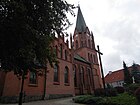You can help expand this article with text translated from the corresponding article in Polish. (October 2012) Click for important translation instructions.
|
| Połczyn-Zdrój | |
|---|---|
 Panorama of the town Panorama of the town | |
 Flag Flag Coat of arms Coat of arms | |
 | |
| Coordinates: 53°46′N 16°6′E / 53.767°N 16.100°E / 53.767; 16.100 | |
| Country | |
| Voivodeship | West Pomeranian |
| County | Świdwin |
| Gmina | Połczyn-Zdrój |
| Area | |
| • Total | 7.21 km (2.78 sq mi) |
| Population | |
| • Total | 8,372 |
| • Density | 1,200/km (3,000/sq mi) |
| Time zone | UTC+1 (CET) |
| • Summer (DST) | UTC+2 (CEST) |
| Postal code | 78-320 |
| Area Code | (+48) 94 |
| Car plates | ZSD |
| Voivodeship roads | |
| Website | www |
Połczyn-Zdrój (Kashubian: Pôłczëno; German: Bad Polzin) is a town in Świdwin County, West Pomeranian Voivodeship, Poland, with 8,372 inhabitants (2010). It is situated on the Wogra River in the historic region of Pomerania.
History
| Year | Pop. | ±% |
|---|---|---|
| 1880 | 4,724 | — |
| 1890 | 4,632 | −1.9% |
| 1900 | 4,956 | +7.0% |
| 1910 | 5,160 | +4.1% |
| 1925 | 5,959 | +15.5% |
| 1939 | 6,920 | +16.1% |
| 1950 | 4,949 | −28.5% |
| 1960 | 7,593 | +53.4% |
| 2010 | 8,372 | +10.3% |
| Source: | ||
Połczyn-Zdrój dates back to an early medieval Pomeranian settlement. The territory became part of the emerging Polish state under Mieszko I around 967. Following the fragmentation of Poland, it formed part of the Duchy of Pomerania. Połczyn was a defensive stronghold located in the Białogard castellany. The town and its castle are mentioned in historical records from 1321 and 1331, respectively, which state that they belonged to a fief that the powerful noble Wedel family had obtained from the Pomeranian dukes. In the 15th century other families were in possession of the town. It had three mineral springs of enhanced iron content and with a temperature between 9 and 11 °C (48 and 52 °F), which were exploited in sanatoriums in order to cure rheumatism. In 1905 the town had a population of 5,046 which in the year of 1925 had grown to 5,960 persons.
Before World War I, the town was known as Polzin. It acquired the name Bad Polzin (i. e., "Bath Polzin", or "Polzin Spa") between the two World Wars. During World War II the Germans established a camp for kidnapped Polish children intended for Germanisation. On 5 March 1945, the town was captured by the Poles and after the end of the war it became again part of Poland, although with a Soviet-installed communist regime.
In the summer of 1945, the communist authorities announced that the population has to leave their home after harvest. However, after the Potsdam Conference evictions were officially postponed to spring 1946. In-officially, the administration was mandated to continue expulsions. According to German witness reports, starting end of October 1945, each night 100-150 Germans to be expelled were forced out of their homes, plundered and sometimes raped.
The town's first post-war mayor was Benedykt Polak, former prisoner of the Oflag II-C German prisoner-of-war camp. In July 1996, after heavy rainfall, the town suffered a flood, after which a new retention reservoir was built between 2000 and 2003.
Gallery
Notable residents
- Anton von Krockow (1714–1778) a Prussian lieutenant general.
- Karl Schröder (1884–1950) a German communist politician and writer
- Friedl Behn-Grund (1906–1989) a German cinematographer
- Volker Vogeler (1930–2005) a German film director and screenwriter
- Bernd Heinrich (born 1940) a biologist and long distance runner
- Susan Denberg (born 1944) a German-Austrian model and actress
- Rosemarie Zens (born 1944) a German writer and photographer
- Robert Atzorn (born 1945) a German television actor
- Stanisław Wziątek (born 1959) a Polish politician, elected to Sejm in 2005
- Janusz Janowski (born 1965) a Polish painter, jazz drummer and art theorist
- Olgierd Moskalewicz (born 1974) a Polish footballer, over 420 pro appearances
- Sławomir Nitras (born 1973) a Polish politician and political scientist, elected to the Sejm in 2015.
- Piotr Kosiorowski (born 1981), Polish footballer, over 200 pro appearances
- Szymon Pawłowski (born 1986), Polish footballer, over 275 pro appearances and 17 for Poland
- Joanna Zachoszcz (born 1993) a Polish swimmer, competed in the women's 10 km at the 2016 Summer Olympics
References
- ^ Stan i struktura ludności oraz ruch naturalny w przekroju terytorialnym w 2010 r. (PDF) (in Polish). Warszawa: Główny Urząd Statystyczny. 2011. p. 109. Archived from the original (PDF) on 13 November 2011.
- Dokumentacja Geograficzna (in Polish). Vol. 3/4. Warszawa: Instytut Geografii Polskiej Akademii Nauk. 1967. p. 39.
- ^ "Połczyn-Zdrój". Encyklopedia PWN (in Polish). Retrieved 1 February 2020.
- Labuda, Gerard (1993). "Chrystianizacja Pomorza (X–XIII stulecie)". Studia Gdańskie (in Polish). Vol. IX. Gdańsk-Oliwa. p. 47.
- Heinrich Berghaus: Landbuch des Herzogtums Pommern und des Fürstentums Rügen. Part III, Vol. 1, Anklam 1867, pp. 690-704, in German (Online)
- JewishGen page for Połczyn-Zdrój
- ^ "1 września. Pamiętamy". Połczyn-Zdrój (in Polish). 1 September 2021. Retrieved 10 November 2023.
- Die Vertreibung der deutschen Bevölkerung aus den gebieten östlich der Oder-Neisse. Dokumentation der Vertreibung der Deutschen aus Ost-Mitteleuropa. Vol. 2. Deutscher Taschenbuch. 1984. p. 735.
- Garczyński, Tadeusz (1977). Połczyn Zdrój i okolice. Przewodnik (in Polish). Wydawnictwo Poznańskie. p. 20.
- "Przeciwpowodziowy zbiornik retencyjny Połczyn Zdrój na rzece Wogrze w miejscowości Połczyn Zdrój, woj. zachodniopomorskie". EkoWodrol (in Polish). Retrieved 1 February 2020.
- IMDb Database retrieved 19 October 2018
- IMDb Database retrieved 19 October 2018
- IMDb Database retrieved 19 October 2018
- IMDb Database retrieved 19 October 2018




